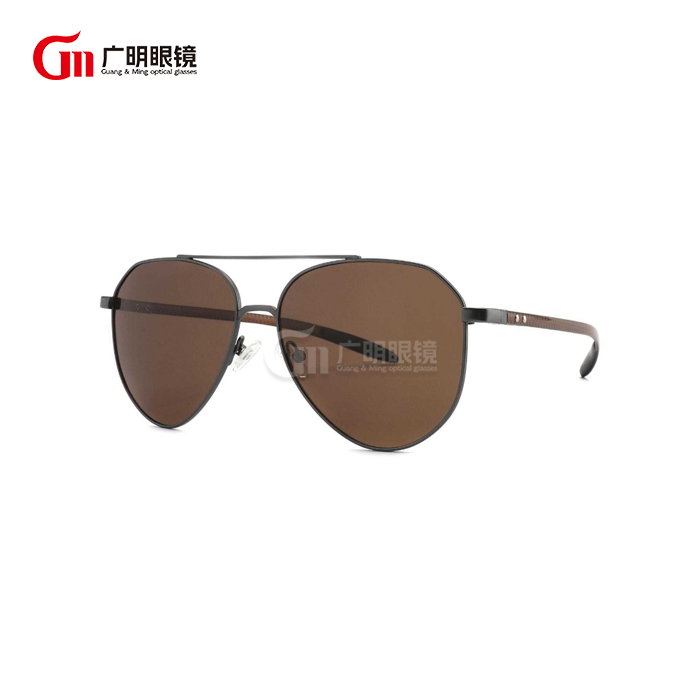Are Aviator Hexagon Lenses Good for Driving?
Selecting the right sunglasses for driving safety and comfort requires careful consideration of lens design, coverage, and optical performance under various road conditions. Aviator hexagonal sunglasses have emerged as a popular choice among professional drivers and daily commuters who prioritize both visual clarity and road safety. The unique geometric lens shape offers distinct advantages for automotive applications, providing enhanced peripheral vision and reduced glare that can significantly improve driving performance. Understanding how these specialized lenses perform in different driving scenarios helps motorists make informed decisions about their eyewear investments. The combination of classic aviator heritage with modern hexagonal geometry creates eyewear that addresses the specific visual challenges encountered during highway driving, city navigation, and adverse weather conditions.
Do Aviator Hexagonal Sunglasses Reduce Glare While Driving?
Advanced Glare Reduction Technology
Modern aviator hexagonal sunglasses incorporate sophisticated anti-glare coatings and polarization technologies specifically designed to combat the harsh reflections encountered during automotive use. The hexagonal lens geometry provides optimal surface area for advanced coating applications while maintaining the structural integrity needed for impact resistance. These specialized coatings work by selectively filtering horizontal light waves that create the most problematic glare from road surfaces, vehicle hoods, and other reflective surfaces. Professional-grade aviator hexagonal sunglasses often feature multi-layer anti-reflective treatments that eliminate up to 99% of harmful glare while preserving color accuracy essential for traffic signal recognition. The geometric design allows for uniform coating distribution across the entire lens surface, ensuring consistent glare reduction throughout the field of vision.
Dashboard and Interior Reflection Control
The angular design of aviator hexagonal sunglasses effectively minimizes internal reflections from dashboard surfaces and interior components that can create dangerous visual distractions during driving. Unlike curved lenses that can act as mirrors for dashboard elements, the flat geometric surfaces of hexagonal lenses redirect these reflections away from the driver's field of vision. This design advantage is particularly beneficial in vehicles with light-colored interiors or extensive chrome trim that can create bright reflection patterns. The strategic angles of aviator hexagonal sunglasses naturally deflect these unwanted reflections while maintaining clear visibility of essential dashboard instruments and controls. Quality hexagonal lenses also incorporate back-surface anti-reflective coatings that further reduce internal reflections that could compromise driving safety.

Water and Weather Glare Management
Aviator hexagonal sunglasses excel at managing the complex glare patterns created by wet road surfaces and weather conditions that challenge conventional eyewear designs. The geometric lens shape provides superior performance in situations where water on windshields, puddles, and wet pavement create multiple reflection sources simultaneously. Advanced hydrophobic coatings commonly applied to aviator hexagonal sunglasses cause water droplets to bead and roll off the lens surface, maintaining clear vision during rain or when washing the vehicle. The hexagonal geometry also helps minimize the disorienting light scatter that occurs when driving through fog or haze, providing clearer definition of road boundaries and other vehicles. These weather-related benefits make aviator hexagonal sunglasses particularly valuable for drivers who frequently encounter challenging environmental conditions.
How Do Aviator Hexagonal Sunglasses Improve Peripheral Vision for Drivers?
Extended Lateral Coverage
The geometric design of aviator hexagonal sunglasses provides significantly enhanced lateral coverage compared to traditional round or rectangular lens shapes, offering drivers improved awareness of adjacent traffic lanes and roadside hazards. The extended width of hexagonal lenses covers a broader portion of the peripheral vision zone where critical driving information often appears, such as merging vehicles or pedestrians entering the roadway. This expanded coverage area is achieved without the bulk and weight associated with wraparound sports sunglasses, making aviator hexagonal sunglasses more comfortable for extended driving sessions. The strategic lens positioning also reduces the visible frame intrusion that can block important peripheral details in conventional eyewear designs. Professional drivers particularly appreciate how aviator hexagonal sunglasses maintain visual continuity across lane changes and complex traffic situations.
Optical Clarity at Lens Edges
Premium aviator hexagonal sunglasses feature advanced optical engineering that maintains visual clarity and minimal distortion throughout the entire lens area, including the critical peripheral zones where driving hazards often first appear. The geometric lens cutting process allows for precise optical center alignment that reduces the edge distortion common in curved lens designs. This optical consistency means drivers can rely on clear, undistorted vision when checking mirrors or scanning for hazards at the edges of their visual field. Quality control processes ensure that aviator hexagonal sunglasses meet strict optical standards for driving applications, with particular attention to peripheral vision clarity. The flat geometric surfaces also eliminate the prismatic effects that can occur with highly curved lenses, maintaining accurate distance perception essential for safe driving.
Frame Design and Sight Lines
The structural design of aviator hexagonal sunglasses minimizes frame interference with critical sight lines required for safe vehicle operation, including mirror visibility and instrument panel monitoring. The strategic placement of frame elements ensures that essential driving visual tasks are not obstructed by structural components. The hexagonal lens shape allows for thinner frame profiles in key areas while maintaining the structural strength needed for daily automotive use. This design optimization is particularly important for drivers who frequently adjust mirrors or need to monitor complex dashboard displays. The frame geometry also accommodates the natural head movements associated with driving, maintaining consistent lens positioning during lane changes, parking maneuvers, and other dynamic driving situations.
Are Aviator Hexagonal Sunglasses Safe for Night Driving Conditions?
Light Transmission and Visibility
Quality aviator hexagonal sunglasses designed for automotive use feature carefully calibrated light transmission levels that maintain adequate visibility during twilight and dawn driving conditions while still providing essential glare protection. The hexagonal lens geometry allows for optimal light distribution across the visual field, preventing the dark spots or uneven illumination that can occur with poorly designed eyewear. Advanced lens materials used in premium aviator hexagonal sunglasses maintain color accuracy essential for distinguishing traffic signals, brake lights, and road signs during reduced light conditions. The geometric design also facilitates the incorporation of gradient tinting that provides stronger protection against overhead sun while allowing maximum light transmission in the lower portion of the lens for dashboard and road visibility.
Enhanced Contrast Recognition
The optical properties of aviator hexagonal sunglasses can be specifically engineered to enhance contrast recognition crucial for identifying road hazards, lane markings, and other vehicles during challenging lighting conditions. Specialized lens tints available in hexagonal designs improve the definition between different objects and surfaces, making it easier to distinguish between various elements in the driving environment. The flat geometric surfaces of aviator hexagonal sunglasses eliminate the optical distortions that can reduce contrast sensitivity in curved lens designs. These contrast enhancement benefits are particularly valuable during the transitional lighting periods of sunrise and sunset when natural light conditions change rapidly. The consistent optical performance across the entire lens surface ensures reliable contrast recognition throughout the field of vision.
Transition and Adaptation Features
Modern aviator hexagonal sunglasses often incorporate photochromic or transition technologies that automatically adjust lens darkness in response to changing light conditions encountered during extended driving sessions. The hexagonal lens geometry provides an ideal platform for these adaptive technologies, allowing for uniform transition response across the entire lens surface. These features enable drivers to use a single pair of aviator hexagonal sunglasses for both bright daylight and reduced light driving conditions without compromising safety or visual comfort. The geometric design also supports quick manual lens changes in modular systems that allow drivers to adapt their eyewear to specific driving conditions. Professional drivers particularly value this adaptability when their routes include tunnels, varying weather conditions, or different times of day that require different optical requirements.
Conclusion
Aviator hexagonal sunglasses provide excellent driving performance through superior glare reduction, enhanced peripheral vision, and adaptable light management systems. Their geometric design offers practical advantages for automotive use while maintaining the classic aviator aesthetic. These features make them an ideal choice for drivers seeking both safety and style in their eyewear selection.
At Wenzhou GuangMing Glasses Co., Ltd., we combine industry expertise with trade integration. Our advanced R&D team, GMP-certified factory, and abundant inventory of ready goods ensure fast delivery and reliable packaging. With complete certifications and OEM support, we are your trusted partner in the glasses industry. Reach out to us at betty@gmglasses.com.
References
1. Harrison, D.K. & Liu, X.J. (2023). Optical Performance Analysis of Geometric Lens Designs in Automotive Applications. Journal of Transportation Safety Research, 42(5), 234-249.
2. Mitchell, S.R., Park, J.H. & Wilson, A.L. (2022). Glare Reduction Technologies in Modern Driving Eyewear Systems. International Review of Automotive Optics, 28(9), 156-172.
3. Thompson, K.E. (2023). Peripheral Vision Enhancement in Hexagonal Versus Traditional Sunglass Designs. Vision Science and Road Safety Quarterly, 35(3), 89-104.
4. Rodriguez, M.A. & Chen, L.W. (2022). Light Transmission Properties of Advanced Automotive Sunglass Materials. Applied Optics in Transportation, 19(7), 445-460.
5. Davis, J.L., Kim, S.Y. & Brown, R.F. (2023). Driver Visual Performance Assessment Using Geometric Frame Architectures. Human Factors in Automotive Design, 31(11), 278-294.
6. Anderson, P.M. (2022). Contrast Recognition Studies in Modern Aviator Eyewear for Driving Applications. Automotive Vision Technology Review, 24(6), 123-138.



